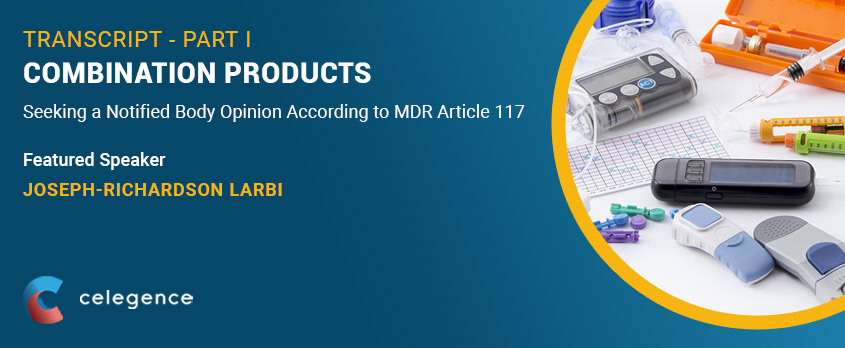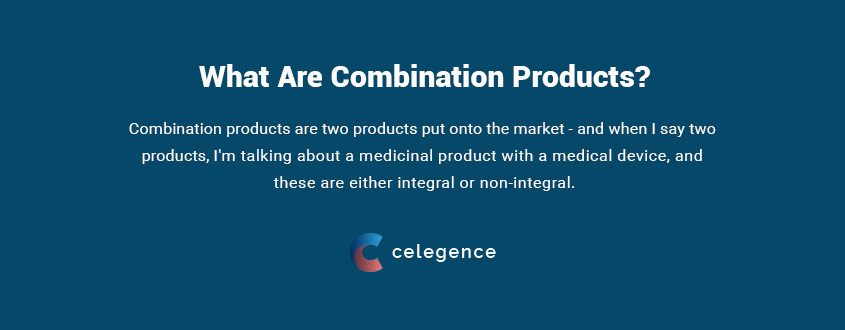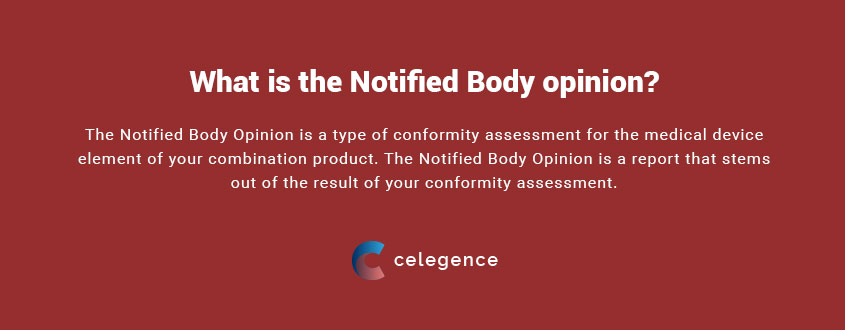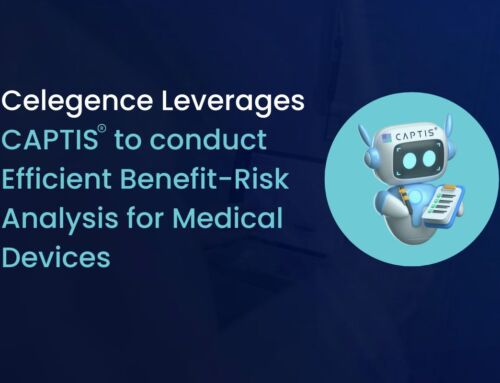
Combination Products: Seeking a Notified Body Opinion according to MDR Article 117 – Transcript – Part 1
Joseph-Richardson Larbi has 18 years of experience in Medical Device (MD & IVD) Regulatory and Quality strategies (from design development to market launch and post marketing activities – compliant to MDD/MDR/IVDR/ISO 13485/9001 Quality Management Systems). He is experienced in MD CE certification, ISO 14971 Risk Management, Manufacturing and Supplier Management, Manufacturing Verification and Validation, Post Market Surveillance, Clinical Evaluation Reports, Drug Device Combinations, regulatory relationship management, and has advanced knowledge of FDA Drugs, Biologics, and Biosimilars (IND, NDA, BLA).
Due to the ever-expanding prevalence and complexity of Drug Device Combination (DDC) products, the EU MDR has put these products under greater focus. Manufacturers of DDCs will now be required to receive Notified Body opinions to ensure the safety and performance of the device element of the combination product. Outlined in Annex 1 of the MDR, the General Safety and Performance Requirements (GSPRs) are required to be met for combination products prior to placing them on the market.
During our webinar titled “Combination Products: Seeking a Notified Body Opinion According to MDR Article 117,” Joseph spoke specifically about combination product types, requirements, the importance of notified body opinions, and the scope of MDR article 117.
Why should you read the transcript / watch this video?
- To comprehend the impact of Article 117 of the MDR on Drug Device Combination (DDC) products
- To understand the current status/requirements for combination products as per MDR
- For an explanation of the new requirements for DDC manufacturers according to the MDR 2017/745
- To gain knowledge on Notified Body Opinions – Requirements & Processes
A full transcript of Joseph’s presentation is available to download (and to read below) and just press play to watch the clip now.

Claim Your Free EU MDR Checklist Now!
Make sure you and your business are compliant with the new EU MDR. Get our 23 page checklist for actionable technical documentation requirements.
Thank you for the introduction and welcome everybody to today’s webinar. We are going to be talking about combination products, but before I do that, I’d like to give you an overview of the medical device regulations – 2017/745 and in particular, article 117 that specifies the requirements for combination products. I know we do have a lot of medical device regulatory professionals on board, but we also have pharmaceutical regulatory affairs professionals on board here as well. And it’s fair to say that the pharma guys might not be as familiar with what’s happening in the medical device world. I’ll take a minute or two to just give you an overview of the medical device world, and then go into article 117 because it specifically addresses bits of the medicinal product directive, which is very important here.
Medical Device Regulations 2017/745 Overview
The medical device regulations are famously abbreviated as the MDR, so I’ll be referring to it as the MDR going forward, but it’s the Medical Device Regulations 2017/745. This was adopted in April 2017 and entered into force on the 25th of May, 2017, by the European commission. This regulation amends 2 or 3 elements. You have the medicinal products directive, the food’s regulation, and you’ve got your cosmetics regulation. The new medical device regulation is amending these 3 directives/regulations. At the same time, it withdraws and replaces two other significant directives. So you’ve got the Active Implantable Medical Device Directive (AIMDD), and then you’ve got the outgoing Medical Device Directive (MDD). So it’s amending, it’s withdrawing, and replacing. That’s an important thing that we need to take here.
Now for the timeline of the MDR – I’ve already mentioned that it was adopted and it came into effect on the 25th of May 2017. However, there was a 3-year transition period. This was from May 2017 to May 2020, called the initial transition period. Now, we all know what happened last year, the entire world experienced a pandemic. So, the European commission acknowledged this, and approached the parliament and said, can we postpone the date of application of the MDR by another year?
And in April 2020, a one year extension was granted, and it was postponed until the 26th of May, 2021.

Combination Products – Types and Requirement
What are combination products? – Combination products are two products put onto the market – and when I say two products, I’m talking about a medicinal product with a medical device, and these are either integral or non-integral. Now, if it’s non-integral, you could have a combination where two separate products are packaged together, so they are co-packaged or non-integral. A good example could be cough syrup, which is a medicine, and a measuring spoon that comes with it. Now the measuring spoon is your medical device, but the cough syrup itself in the bottle is the medicine. So these would be non-integral, since they are separate, but they’re put into the same box. So that’s a non-integral combination product.
Combination products are a combination of products being put together. They could be co-packaged together, or they could be integrated into one. An example of an integral combination product would be your EpiPen device or insulin pen device, where the device contains the insulin, which is the medicine, and the actual device that administers the medicine, and the syringe itself is the medical device.
Medicine: As per the Medicinal Products directive – any substance or combination of substances presented as having properties for treating or preventing diseases in human beings and then there is a second part to it. Any substance or combination of substances which may be used in, or administered to human beings, either with a view to restoring, correcting, or modifying physiological functions by exerting a pharmacological, immunological, or metabolic action, or to make a medical diagnosis.
Medical Device: Any instrument, apparatus, appliance, software, implant, reagent, material, or other article used alone, or in combination for human beings for a specific medical purpose. Some of the medical purposes are – to diagnose, prevent, monitor, treatment of diseases or to monitor, treat, or compensate for an injury or disability, and additionally, the investigation, replacements, or modification of the anatomy or of a physiological or pathological process or state. So this particular instrument, apparatus, or software does not achieve its principal intended action by pharmacological, immunological, or metabolic means.
If it does any of these by a pharmacological way, immunological way, or metabolic means, then it’s primarily a medicine.

Claim Your Free EU MDR Checklist Now!
Make sure you and your business are compliant with the new EU MDR. Get our 23 page checklist for actionable technical documentation requirements.
Types of Combination Products
What are the types of combination products? As I mentioned earlier, you’ve got your pressurized metered dose inhalers as an example of a combination product, the blue parts that you see on the screen of your inhaler is the actual device, which helps to deliver the actual medicinal products which will be in the canister at the top.
Pre-filled Syringes – the syringe itself is your medical device and what is administered as the medicinal substance will be the medicine.
Drug Eluting Stents – this shows how far science and technology has come. If you’re not familiar with drug-eluting stents, then please go onto YouTube after this webinar and just have a look at how it operates. But for your drug-eluting stents, it’s a medical device that goes into the artery to open up the veins and the medicinal product then flows through.
What is the current status/requirement for combination products?
Now that we are still in the transitional period of MDR, what is the current status or requirement for combination products? I have split this into non-integral products and integral products. Bear in mind that the non-integral, or core package separately, is out of scope of article 117. So the products like your cough syrup that comes with a measuring spoon, are out of scope. The reason why they are out of scope is because your medicine will go through its own market authorization approval process. The measuring spoon as a medical device will then go through its conformity assessment with the notified body and will be CE marked accordingly, and then they will be all packaged together. So that’s out of the scope of article 117.
Integral combination products – This will be a medical device and medicinal substance integrated as one unit. I have some examples here: Pre-filled Syringes and Drug Eluting Stents. The medicinal component will go through the market authorization approval process and in addition to that, for your medical device element, you will have to make sure that it conforms with the essential requirements of the medical device directive. This is the status quo. At the moment, manufacturers are allowed to self-declare that they are compliant to the medical device directive by showing compliance to the essential requirements and then their paperwork gets reviewed by the competent authority.
What are the New Requirements for Manufacturers According to MDR 2017/745?
The articles that are relevant to combination products are found in article 117 of the MDR, Article 1 – Sections 8 & 9, and then Annex 1 of the MDR, which specifies your general safety and performance requirements. So these are the three things that will regulate combination products. MDR actually amends the heart of your medicines product directive 2001/83. So let’s get into it and find out what the actual requirements are come the date of application of MDR, which is the 26th of May 2021.
MDR Article 117
I have highlighted a few sections that are very, very important for us to go through. I just want you to get the foundation of what is actually needed. According to article 117, it starts off by saying
“Devices or products as referred to in the second paragraph of article 1 – section 8 and it’s sub paragraph, then you’ve got article 1 – section 9 and the sub paragraph of that.”
So we’ve got two paragraphs that we need to then refer to later on. Here I am referring to article 1 – section 8, and specifically the second paragraph of it. And then you’ve got article 1 – section 9 and it’s second paragraph. So these are the two paragraphs that we will be paying attention to.
For these products, the marketing authorization dossier shall include the results of the assessment of the conformity of the device with the relevant general safety and performance requirements of the MDR, or the relevant certificate issued by a notified body allowing the manufacturer to affix the CE Mark to the medical device. Now if the dossier does not include the results of the conformity assessment referred to in the first paragraph, then the involvement of a notified body is required in accordance with the regulation or the MDR. It states that the competent authority shall require the applicant, the manufacturer, to receive an opinion on the conformity of the device part with the relevant GSPRs as set out in Annex 1 of the MDR, and this shall be issued by a notified body designated in accordance with the regulation for the type of device in question.

Notified Body – Role
Who is a Notified Body and what role do they play? What’s the importance of a Notified Body?
Notified bodies are designated by a competent authority to conduct conformity assessments under a particular given regulation. In this case, we are talking about the MDR 2017/745. For example, you’ve got the HPRA in Ireland, and they will designate organizations to be considered a Notified Body and can carry out conformity assessments. Your conformity assessment will go through your technical documentation and your technical file to make sure that you are meeting the requirements of the particular regulation in question.
When they carry out a conformity assessment, you will then have their authority to use their unique identifier on your product. So when we are talking about devices that are going to Europe, you will have your CE marking that goes onto the product and underneath the CE Mark, and then you will have your 4-digit code that then identifies the notified body. If something goes wrong on the market and your competent authority gets involved, they can easily look at the device in question. They will have a look at the identifier and they will be able to know which notified body actually approved that device. They can approach the notified body and say, we’ve got this product that is behaving in this way. Can you show us some type of documentation on it? Safety or performance requirements? And the notified body will be obliged to give out such documentation.
Notified Body Opinion – Requirement/Process
What is the Notified Body opinion? The Notified Body Opinion is a type of conformity assessment for the medical device element of your combination product. The Notified Body Opinion is a report that stems out of the result of your conformity assessment. Typically, it is 20 pages and could take 2 to 6 months of review by the notified body to actually get your notified body opinion to get that report. It is made up of two elements. One is the technical documentation review, and then an additional documentation review.
They will assess these elements of your medicinal products. Now talking about cost. It varies depending on the notified body that you approached, and the type of service that you go for. From my experience, it could be in the region of 20,000 to 65,000 Pounds. Keep in mind that this doesn’t mean it cannot go beyond 65,000 pounds depending on the therapeutic area that you are working on. But from my experience, the ones that I’ve worked on were in the region of 20,000 to 65,000 pounds.
Celegence would be able to assist you when your organization approaches notified bodies, as well as receive these relevant quotations and be able to complete all the work for you.
To conclude this discussion, a notified body opinion is a report based on the conformity assessment of meeting the requirements of the MDR, and thus, you will need to meet the general safety and performance requirements of the MDR.


